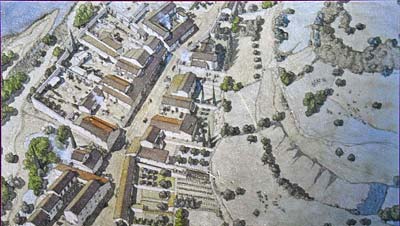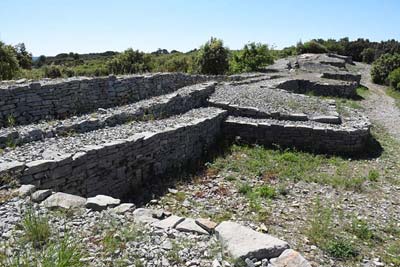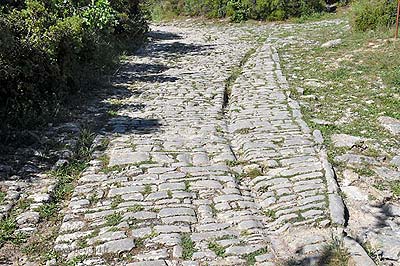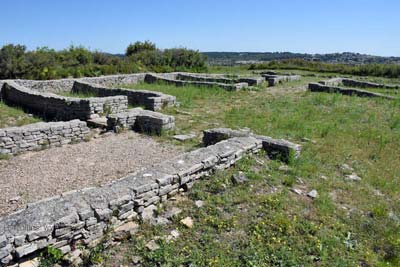Ambrussum
Gallery of 13 photos for Ambrussum
Ambrussum is a Pre-Roman oppidum and Roman archeological site in Provence, once a staging point and small town on the Via Domitia, the Roman road between the Alps and the Pyrenees.
Roman Sites | Prehistoric | Ambrussum | Ambroix Bridge | Domitienne Way |
Ambrussum is located just southwest of Nîmes where the Roman Domitienne Way (Voie Domitienne) crossed the Vidourle on the Pont Ambroix.
The site includes a visitor center with a small historical museum.
Staging Post
 The lower part of the site, beside the river, was a large staging area (relais routier), which the Romans installed every 10-15 km along their main routes. The Ambrussum stop is exactly midway between Nîmes and Castelnau-le-Lez (Sextantio), in the direction of Beziers and Narbonnes. This stop was created around 30 BC and was almost a small town, covering over two hectares (5 acres) along both sides of the Via Domitia.
The lower part of the site, beside the river, was a large staging area (relais routier), which the Romans installed every 10-15 km along their main routes. The Ambrussum stop is exactly midway between Nîmes and Castelnau-le-Lez (Sextantio), in the direction of Beziers and Narbonnes. This stop was created around 30 BC and was almost a small town, covering over two hectares (5 acres) along both sides of the Via Domitia.
The remains here are only the foundations, visible in the fields on the other side of the fence beside the current dirt track. Information panels have facsimile drawings and information in French and English.
 The remains here are only the foundations, visible in the fields on the other side of the fence beside the current dirt track. Information panels have facsimile drawings and information in French and English.
The remains here are only the foundations, visible in the fields on the other side of the fence beside the current dirt track. Information panels have facsimile drawings and information in French and English.
The staging area was a Roman mansio, an official stopping place for Roman officials and travelers on official business. The Ambrussum site included hotels, baths and industrial buildings, beside the Pont Ambroix across the river.
Oppidum
 The hilltop site Colline de Devès had human settlements as far back as 2300 BC. A bit more recently, the Gauls built a walled settlement here around 300 BC. From this hilltop vantage point, you can see the Nages Oppidum on its hilltop to the northeast, towards Nîmes.
The hilltop site Colline de Devès had human settlements as far back as 2300 BC. A bit more recently, the Gauls built a walled settlement here around 300 BC. From this hilltop vantage point, you can see the Nages Oppidum on its hilltop to the northeast, towards Nîmes.
 The Romans conquered the area around 120 BC, and fortified the oppidum with an improved surrounding wall including 21 towers. The 5 hectare (12 acre) enclosed space included an active town, especially from the time of the Ambroix bridge and staging area, 30 BC, until about 100 AD when it was abandonded.
The Romans conquered the area around 120 BC, and fortified the oppidum with an improved surrounding wall including 21 towers. The 5 hectare (12 acre) enclosed space included an active town, especially from the time of the Ambroix bridge and staging area, 30 BC, until about 100 AD when it was abandonded.
 The paved road through the center of the oppidum was built around 100 BC. In this section [our photo] leading in from the east gate the worn tracks of the the Roman wagons are clearly visible.
The paved road through the center of the oppidum was built around 100 BC. In this section [our photo] leading in from the east gate the worn tracks of the the Roman wagons are clearly visible.
 Apart from the paved road at the east gate, there are three interesting excavation sites to visit inside the oppidum: the Place au Portique with a large roofed meeting hall, the Southern District residential area [our photo] and the Northern District residential area beside the exposed part of the defensive walls. Information panels at each location include drawings showing what the original Roman buildings probably looked like.
Apart from the paved road at the east gate, there are three interesting excavation sites to visit inside the oppidum: the Place au Portique with a large roofed meeting hall, the Southern District residential area [our photo] and the Northern District residential area beside the exposed part of the defensive walls. Information panels at each location include drawings showing what the original Roman buildings probably looked like.
Ambrussum Tour
To tour the Oppidum site, you can walk down the main path to the Pont Ambroix, then branch right, up the hillside and loop through the main oppidum archeological sites.
The full loop, with a lot of wandering around the sites, was 2.3 km. It took us two hours, with most of the time spent on sightseeing Roman remains, bridge, river, birds, wildflowers and scenery, and very little of the time actually walking.
Guided Visits are available of the oppidum site on Saturdays and Sundays, Oct to May, according to the information panel. We were there on a Sunday in May (2016) and the museum and reception area were closed.
Other Pre-Roman, Roman Sites
The Nages Oppidum (Oppidum de Nages; Oppidum des Castels) is about 15 km NE.
The Rocher du Causse Oppidum is 40 km (by road) to the NW.
The prehistoric site of Cambous is 50 km to the west.




 After 25 years online, I've decided to remove all Ads from my one-man web Provence Beyond. If the content is enjoyable or useful to you, I would really appreciate your support.
After 25 years online, I've decided to remove all Ads from my one-man web Provence Beyond. If the content is enjoyable or useful to you, I would really appreciate your support.